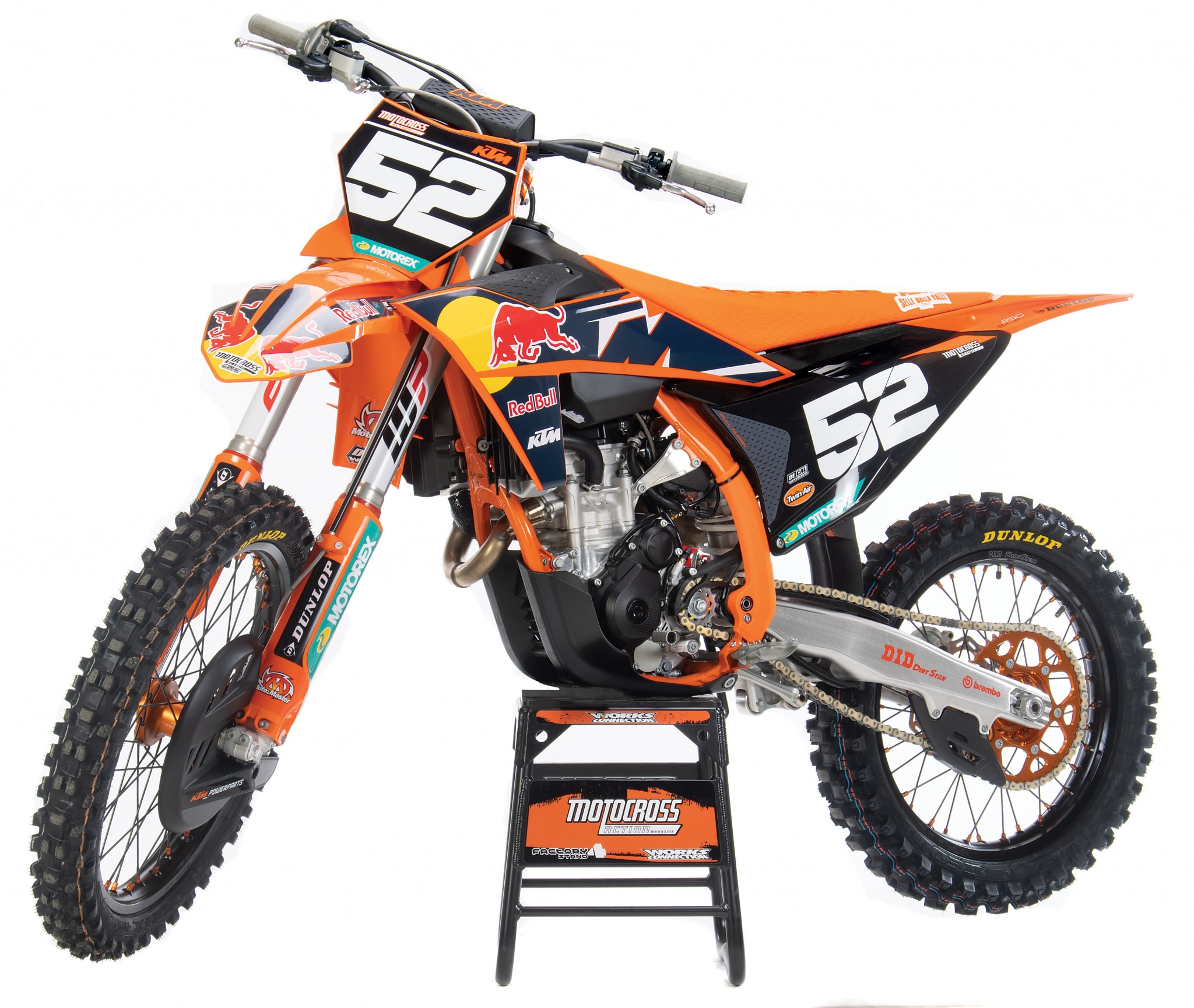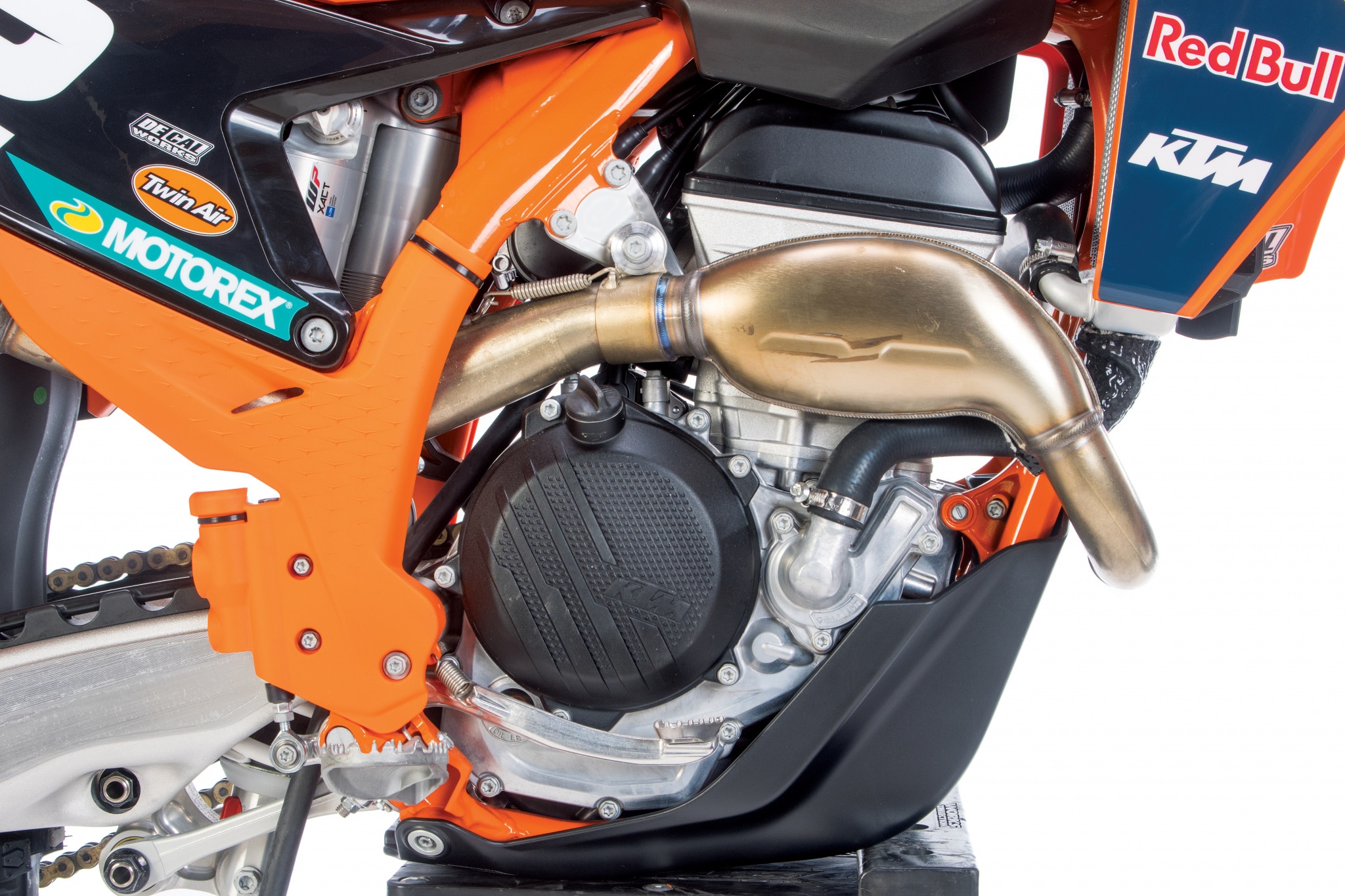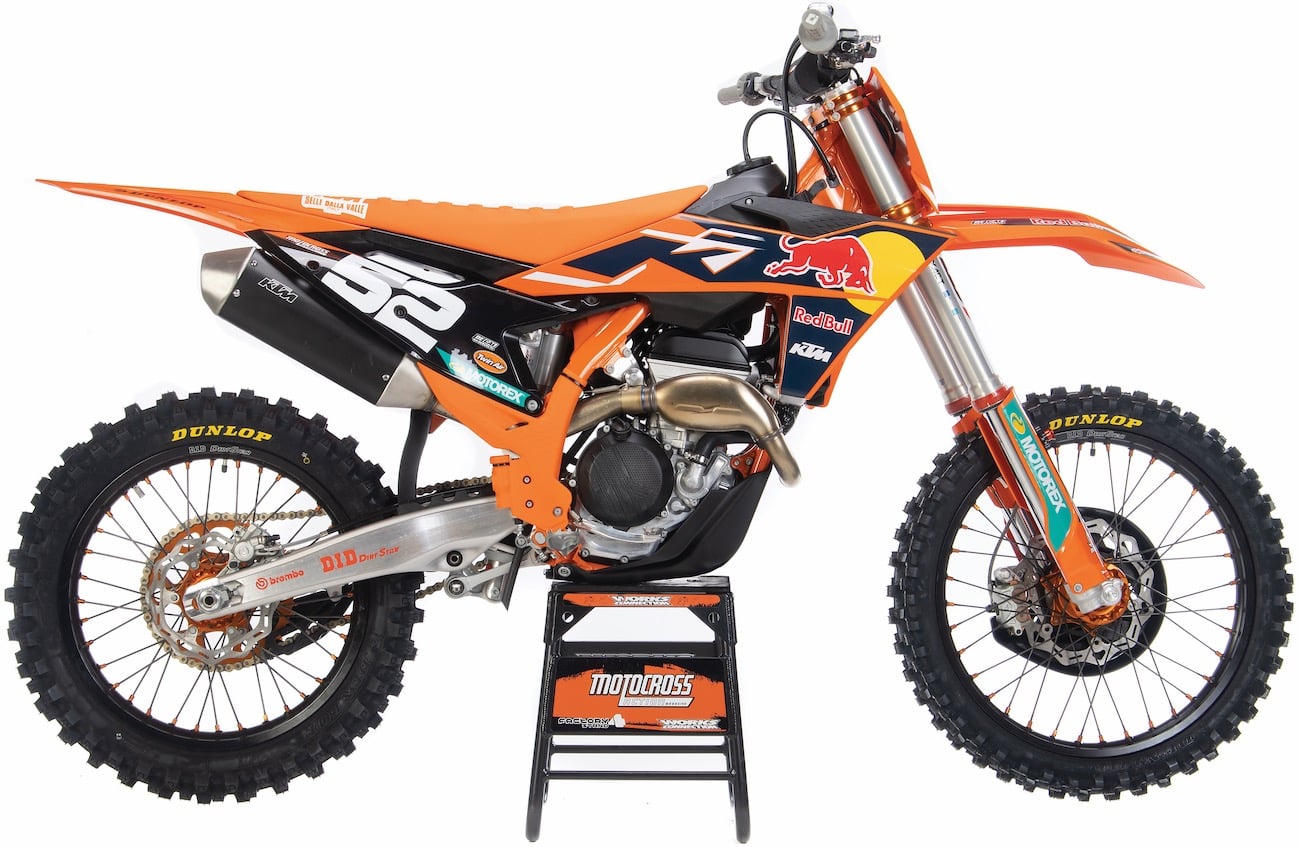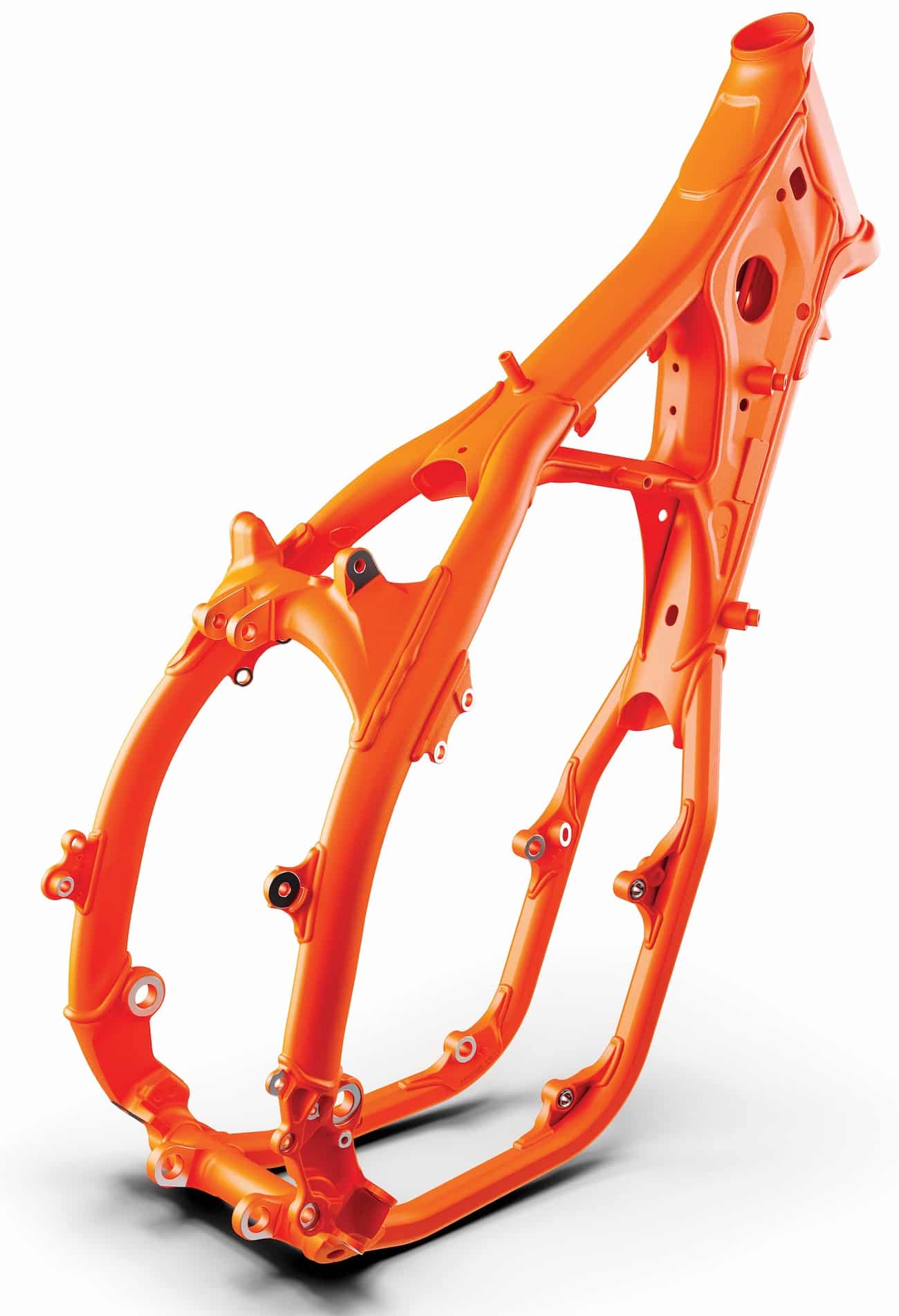MXA RACE TEST: THE REAL TEST OF THE 2022-1/2 KTM 250SXF FACTORY EDITION

Q: DID THE 2022 KTM 250SXF FACTORY EDITION GET ALL OF THE SAME CHANGES AS THE 450?
A: The 250SXF Factory Edition received the same chassis updates as the 450SXF, and it also received an all-new engine.
The 250 and 450 share the exact same hydro-formed Chromoly steel frame and aluminum/injection-molded, polyamide carbon subframe. No longer is the frame different for the 250 and 450 models, and we believe all the 2023 models will have this same skeleton, even the two-strokes. Both bikes also received a stiffer die-cast aluminum swingarm, downsized 22mm rear axle, updated electronics with new maps and Quick Shift, all-new bodywork, an updated WP rear shock, re-valved WP front forks and new footpegs. The 250 also has all the standard Factory Edition upgrades, including the Factory wheels, skid plate, split triple clamps, Red Bull KTM graphics, start device and more.
Q: WHAT’S NEW ABOUT THE 250SXF ENGINE?
A: From the outside, the Factory Edition 250SXF engine doesn’t look wildly different, but internally it’s all new. It is tilted 2 degrees backwards (when compared to last year’s position) for better mass centralization and to reduce chain torque. It has an 8mm-shorter total height and 3mm-lower countershaft sprocket. The cylinder head is lighter, and it has a larger 27.5mm exhaust valves (up from 26.5) for optimized fuel flow to work with the bigger bore and shorter stroke. The compression ratio is also increased from 14.4 to 14.5.
Q: WHAT WAS THE THOUGHT PROCESS BEHIND AN ALL-NEW ENGINE?
A: The KTM 250SXF engine has pioneered the big-bore/short-stroke engine theory in the 250 class. KTM’s 250SXF had a new engine in 2013 that increased the bore and stroke from 76.0mm x 54.8mm to 78.0mm x 52.3mm. This concept originated in road racing, and the bigger bore inside of the cylinder creates more room at the top of the cylinder for the engine to have bigger intake and exhaust ports. With bigger ports, the valves can allow more air and fuel to get in and out of the combustion chamber, which creates more power. The shorter stroke also equates to higher rpm, hence the 14,000-rpm rev limiter.
Now, with the 2022-1/2 Factory Edition 250SXF, the Austrians have taken this concept even further, going to an 81mm bore and 48.5mm stroke.
Q: HOW FAST IS THE 2022-1/2 KTM 250SXF FACTORY EDITION?
A: The current 2022 KTM 250SXF engine has been ultra-strong, but it’s not as exciting in the midrange as a Yamaha YZ250F. Even though it has more torque and more horsepower than the YZ250F at every point on the dyno curve (peaking at 43.8-horses versus 42.6 for Yamaha), the KTM 250SXF still doesn’t provide the same excitement levels and “hit” that you feel on a YZ250F. By the same token, the YZ250F can’t keep pace with the KTM 250SXF once the rpm kicks in. Most MXA test riders prefer racing the KTM 250F power over the Yamaha power. For 2023, KTM still wanted to silence the naysayers and create more excitement down low with its all-new big-bore/short-stroke 2023 engine.
We were surprised that there wasn’t more of a difference between the current 2022 250SXF and the 2022-1/2 250SXF Factory Edition engines on the dyno. To state it simply, they both have the same peak torque and horsepower numbers, only the new bike gets there easier. From zero to 9500 rpm, the new engine is only slightly stronger. Then, it makes about 1 horsepower more all the way up to 13,700 rpm. Surprisingly, the current 2022 powerplant catches back up to the new one right at the end to claim 44.24-horsepower (the Factory Edition hits 44.36). When it comes to torque, both engines peak at 20.9.
The new bike certainly felt faster on the track. The bottom end was improved, as our testers were able to get up to speed quicker to hit the doubles on the corner exit with less effort from the new engine; however, the engine still needs to be revved to get your money’s worth. We have begged for more excitement down low on the 250SXF for a long time, and we’re finally starting to see our wishes come true; but, it’s still a KTM, and that means it makes its best power when revved.

Q: HOW DOES THE FACTORY EDITION HANDLE?
A: We love the current generation 2022 KTM 250SXF, and although KTM and Husqvarna have won many of our shootouts lately, the wrecking crew is a hard crowd to please. Just because the previous bike was good and KTM says that this one is better doesn’t mean it actually is. Additionally, because we like the handling of the current generation of bikes so much, we’re going to scrutinize the new bike with an eagle eye.
Our first impression was that the Factory Edition is taller in the pits and on the track when compared to the current bike. Right away when you sit on the new model, it’s harder to touch the ground. Then, once you’re on the track, that same feeling translates into the handling of the bike. The rear end sits up higher in corners and doesn’t squat down nearly as much when you open the throttle. At first it feels weird, but KTM designed the new chassis and engine to work this way. On the 2022 bike, the shock mounted to the backbone of the frame at the top. With this design, there’s a direct line of communication between the top of the shock and the steering tube. The energy generated from hitting bumps or landing from jumps transfers into the backbone all the way to the head tube. For the new frame, KTM created a new, separate shock tower that dissipates energy that would normally be transmitted forward by the frame’s backbone. Reducing this energy creates more stability and increases traction. It also lessens fatigue in your hands, as the shock doesn’t transfer energy directly to the steering stem anymore.
The second thing you notice when comparing the new bike back to back with the current 2022 model is that the suspension soaks up bumps better on deceleration. This is a definite plus and is also a result of the new frame. The third aspect of the handling that stands out is just how stiff this new frame and suspension are. We have learned in previous model years that it takes a couple hours for the WP XACT air forks to break-in fully and begin to feel good, but with this bike it took twice that amount of time before we felt comfortable on it. The frame and suspension are great on a smooth track, but if you ride this bike on a choppy, rough track before you hit the 5-hour mark on the forks or the 10-hour mark on the frame, good luck! The forged brackets that brace the top and bottom of the frame’s head tube create Pro-ready stiffness that won’t be Vet-ready without a lot of break-in time.
The new engine is a factor in the handling of the bike, as it is rotated 2 degrees back and lowered 3mm to get the countershaft sprocket closer to the swingarm pivot. This is a time-honored strategy, developed by Eyvind Boyesen and Horst Leitner, to reduce chain torque, which prevents excess squatting under acceleration. In short, the anti-squat frame geometry and input of the more powerful engine cause the rear end to ride higher. It’s something that KTM was aiming for, but it felt foreign to our test riders.
Q: HOW IS THE SUSPENSION?
A: WP suspension has always been controversial. Consumers either love it or hate it. Air forks are especially polarizing, as their reputation has been completely tarnished by previous iterations from KYB, Showa and even WP. Most of it is misguided old wives’ tales, but some of it is based on the reality of forks that take longer to break-in than most people ride in six months.
The structure of the Factory Edition forks is actually very similar to the current model’s forks, the only difference being the specific settings tailored for this bike, and it has all-new bottoming cones. As for the shock, it’s totally revised both internally and externally. It’s short and stubby with a much shorter shock body and fork spring length. Still, even with a 20mm-shorter overall length and 20mm shorter spring, the travel remains the same at 300mm.
The Factory Edition suspension has valving that is certainly stiffer than the current 250SXF valving. It holds up more in the front and rear, inspiring confidence for faster and heavier riders. Our settings were close to stock on smooth tracks and all over the map on rough tracks until we hit the 10-hour mark. Then, we went back to the baseline setting of the past two years for compression and rebound to firm it up even more. Good news for those of you who made a killing in the stock market—your Pro Component Cone Valve forks will fit right on the Factory Edition.

Q: WHAT DID IT WEIGH?
A: The new KTM 250SXF is in the bulking-up phase of life, and we can only hope that the Austrians will enter their Jenny Craig phase to trim the machine back down to its fighting weight in 2024 (it’s too late for 2023). One of the biggest selling points for KTM over the last few years has been its light overall weight. Less weight equals more horsepower. Less weight means you’ll be able to stop quicker for turns. Less weight means that your suspension won’t have to work as hard to hold you in the correct position. Less weight means that you can lean it over easier in corners, and less weight means that it’s easier to pick the bike up off the ground, put it on the stand and load it up into your truck.
KTM has had the lightest bikes for quite a while now. The stock 2022 KTM 250SXF weighs 218 pounds, while the 2022 GasGas MC 250F hits the scales, with a few different parts, at 217 pounds. To answer the question you want answered, the new 2022 Factory Edition 250SXF hits the scales 9 pounds heavier than the current 250SXF at 227 pounds (the 450SXF Factory Edition weighs 231).
Okay, maybe we’re overreacting a little bit. This is a “Factory Edition,” which means that KTM has added a few extra parts. If you took off the front brake rotor guard, the skid plate, the PowerParts Factory wheels, gripper seat cover, holeshot device and split triple clamps—all of which won’t be coming on the 2023 production bike, it could be 4 pounds lighter, bringing it to 223 pounds. Still, that won’t be as light as a GasGas MC 250F (217 pounds) or 2022 Honda CRF250 (219 pounds). But, it will be lighter than the Kawasaki KX250 (228), Yamaha YZ250F (227) and Suzuki RM-Z250 (227).

Q: WHAT DID WE HATE?
A: The hate list:
(1) Seat height. We said this about the 450 Factory Edition, and we’ll say it again: the new Factory Editions are too tall. That is why we have been more excited to race the 2023 Husqvarnas—which come with their trademark lowered chassis.
(2) Checklist. Check the bolts on the rear sprocket, shift lever, shock linkage, head stays, front motor mount and swingarm pivot at regular intervals.
(3) Clickers. The compression clickers on the forks are too short and hard to turn. The rear shock’s high-speed compression adjuster, low-speed compression adjuster and rebound adjuster need no tools to be manipulated. Sadly, the shock’s rebound clicker can be very difficult to adjust by hand, but, thankfully, the adjuster can still be turned with a flat-bladed screwdriver.
(4) Buttons. We like the push buttons on the new electronics for start, stop, traction control, maps and Quick Shift, but the buttons are so low-profile that using them while wearing gloves is hit or miss. The buttons need to stick up higher.
(5) Chain slack. The Factory Edition owner’s manual says to measure chain slack at 58mm at the back of the chain buffer pad, but KTM’s engineers told us to go to 70mm.
(6) Mapping. We wish there were a bigger difference between Map 1 and Map 2.
(7) Number plate. The triple clamp protector wings on the front number plate look horrible and don’t even protect all of the lower clamp.
(8) Guide-N-Slide. The chain guide and slider both wear out extremely easily. This is a byproduct of the lowered countershaft sprocket. We recommend buying new ones from TM Designworks instead.
(9) Plastics. The exotic flow of the bodywork is growing on us, but the tip of the left side shroud hits the front fender when you turn it to the stops. It doesn’t affect performance; it just isn’t right.
(10) Clutch cover. The black anodizing on the clutch cover started wearing from our boot after the first ride. It’s not a great look.

Q: WHAT DID WE LIKE?
A: The like list:
(1) Shock collar. Finally, after years and years of riders begging, WP bit the bullet and spent R&D time and money on developing a plastic shock collar that doesn’t deteriorate after the first time you set the sag.
(2) Cross-three spokes. The more spokes that an individual spoke crosses over on the way from the hub to the rim, the stronger and more forgiving the wheel. The Factory Edition front wheel is laced cross-three.
(3) Quick Shift. Starts will never be the same (although many test riders wish it could be turned off on-the-fly verywhere else on the track).
(4) Air filter. We love that KTM specs Twin Air filters and that they are so easy to install and remove. The only problem is that the new air box shape requires a new air filter shape to go with it. We have lots of old filters that won’t fit this bike.
(5) Airbox cover. Finally, an airbox cover that’s actually easy to remove thanks to an extended handler at the upper front that you can tug on.
(6) No-tools clickers. You can adjust the WP shock and forks without using a tool. Low-speed compression, high-speed compression, shock rebound, fork rebound and fork compression are all adjusted by hand.
(7) Vented airbox cover. The bike comes with an optional vented airbox cover that improves throttle response.
(8) Engine. The new bike is easier to ride, although it’s not a whole lot better on paper.
(9) Pucker power. Brembo still makes the best brakes.
(10) Kill button. KTM combined the start and kill buttons on the same switchgear. Now if only we could retrain our brains to remember to stop reaching for the kill button that isn’t on the left.
(11) FI light. In 2022, the FI diagnostic’s LED light fell out of its holder constantly. On the Factory Edition, this light has been moved to the hour meter, and we haven’t had any issues.
(12) Fork guards. New fork guards wrap farther around the exposed fork legs to cut down on chrome dings.
(13) Spacers. The rear axle is downsized from 25mm to 22mm to add flex, but last years wheels won’t fit until you change out the inner spacer tube in the hub and the 2023 wheel bearing seals. You will need to use the 2023 wheel spacer on your old wheel.
Q: WHAT DO WE REALLY THINK?
A: When a manufacturer builds a 450 four-stroke, the focus is on building a comfortable chassis and an engine that is smooth and rideable; however, in the 250 class, power is king. The 2022 KTM 250SXF Factory Edition is faster than before, and, best of all, the power is easier to access. When it came to rough tracks, our test riders didn’t love the KTM 250 Factory Edition at first. But once the suspension and frame broke in, we learned how to ride it with less squat under acceleration. Eventually, most, but not all, of our test riders chose to race the new bike over the old one when comparing them back to back.

MXA’S 2022-1/2 KTM 250SXF FACTORY EDITION SETUP SPECS
This is how we set up our 2022-1/2 KTM 250SXF Factory Edition suspension for racing. We offer it as a guide to help you find your own sweet spot.
WP AER FORK SETTINGS
There is a learning curve to getting the most out of the WP XACT air forks. The KTM WP XACT air fork has one Schrader valve to put air in or take air out. The right fork leg is strictly damping, and the left leg is air only. KTM has a sticker on the air leg to guide you to the recommended air pressure. It is a very good starting point, but it’s just a suggestion, not an ironclad law. MXA has test riders who run as much as 165 psi and test riders who run as low as 135 psi. The 2022-1/2 forks have the potential to be great. For hardcore racing, we recommend this fork setup for an average rider on the 2022-1/2 KTM 250SXF Factory Edition.
Spring rate: 156 psi (10.8 bar)
Compression: 9 clicks out (12 clicks out)
Rebound: 16 clicks out (18 clicks out)
Fork-leg height: Second line
Notes: The 2022-1/2 KTM 250SXF Factory Edition WP XACT air forks took five hours to break in, but once they did, we were able to get full travel and find more comfort at the corner entrance. Be sure to bleed the forks before you ride in the morning and at least once throughout the day if you’re riding multiple sessions.
WP SHOCK SETTINGS
Even with the new chassis and shock, we still felt the most comfortable with the sag set at our standard 105mm. It was also nice to be able to adjust the shock clickers by hand, except you need a flathead screwdriver to get to the rebound adjuster down below. For hardcore racing, we recommend this shock setup for the 2022-1/2 KTM 250SXF Factory Edition:
Spring rate: 45 N/mm (for 175 and up pounds), 42 N/mm (for riders under 175 pounds)
Race sag: 105mm
Hi-compression: 1-1/2 turns out
Lo-compression: 10 clicks out
Rebound: 14 clicks out
Notes: Static sag, measured without the rider on the bike, should be between 30mm and 40mm. To measure static sag, first set your race sag to 105mm. Next, take the bike off the stand and have someone hold it vertically while you measure how much the rear suspension sags without a rider on it. If your static sag is more than the recommended 40mm, your spring may be too stiff for your weight. In this case, the spring is not compressed enough to allow the suspension to extend far enough on its own. If your static sag is less than 30mm in the rear, the spring may be too soft for your weight. In this case, the spring requires so much preload to achieve the proper race sag that it makes the rear suspension prone to topping out under a load.














Comments are closed.